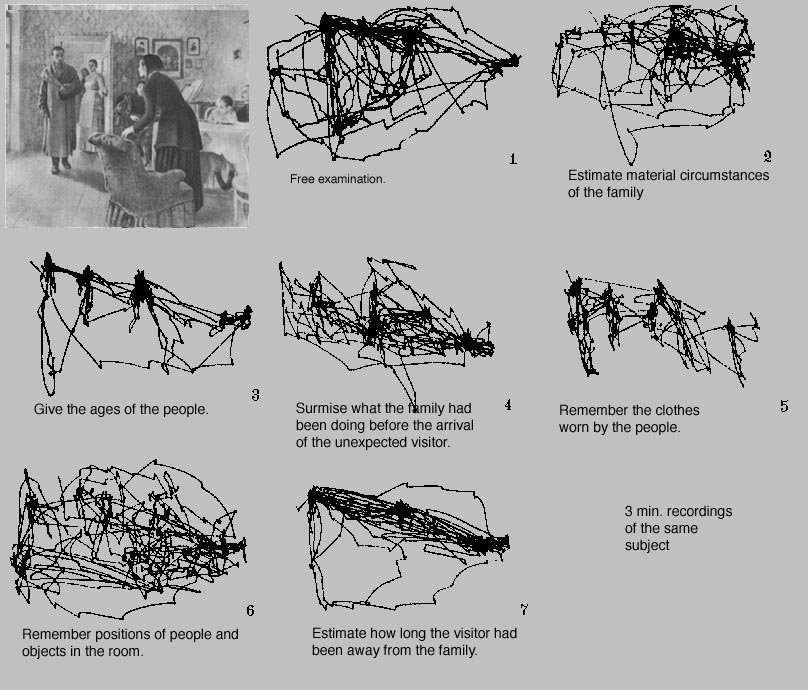This post is also available in Dutch.
Eye movements play an important role in visual perception. But why do we move our eyes three times a second? And how does the brain handle so many movements?
 Mona Lisa, by Leonardo da Vinci (public domain)
Mona Lisa, by Leonardo da Vinci (public domain)
Each element on your computer screen, and every word in this text, requires an accurate eye movement towards it. This comes with a burden for the brain: each eye movement requires precise planning. Often we do not realize how much work our brains do in order to handle this.
Why do we move our eyes?
When we stare at a certain direction, the total area in which we can see objects is called the visual field. However, we can only see a small region of this field in great detail. This high-definition region is referred to as fovea (and what we see from this region is referred to as foveal vision) and it is smaller than 2% of the entire visual field. In terms of reading, foveal vision is about the size of a 5 to 8 letter word. The rest of our vision is out of focus; we see just enough to detect shape of objects, movements and flashes.
We also move our eyes because of the have light-sensitive cells that we have in the retina (a layer in the eye). Since these cells are sensitive to changes in light rather than to light itself, if we did not move our eyes between fixations, we would be blind (Actually, there are ways to experience temporary blindness at home, by physically preventing the eyeball’s movement for a few seconds!).
For clear vision, we need to direct the fovea to the points of interest. This means, that we bring an object into the high definition foveal region. To do so, we end up moving our eyes about 3-4 times per second. That’s about 170.000 times per day! This makes the eye muscles the most active muscles in the body.
What type of eye movements do we make?
We make different types of eye movements depending on what we want to see:
- Vergence movements direct both eyes to the same point, based on the distance of the objects we want to focus on.
- Smooth-pursuit eye movements helps us follow moving objects with our eyes by keeping their images stable on the fovea; be it a passing train, a flying bird or a prey.
- Saccades are fast eye movements between different points in the visual field. They are the fastest and jerkiest eye movements, sometimes taking only 20 miliseconds!
- Tremor and drift prevent objects from fading perceptually by making many consecutive miniature eye movements.
- The vestibular-ocular reflex keeps vision still while we move our head by moving the eyes to the opposite direction.
 Eye movements measured while people look at a picture with different goals. (Yarbus, 1967; public domain)
Eye movements measured while people look at a picture with different goals. (Yarbus, 1967; public domain)
As fast and accurately as possible
We have no conscious control over the speed of the eye, so how do they move? Well, our eyes should move as fast as possible in order to minimize the duration of movement. However, when the eyes move too fast, stopping the eye balls at exactly the target point (also known ‘end-point’) is harder. This is because the speed of the eyes determines the duration of the eye movement and accuracy of the end-point. Research shows that our brains deal with this issue by making the best “speed-accuracy trade-off” possible.
As you can see, the control of the eyes is an amazing function of the brain, but not one that we regularly attend to. Maybe, the next time you look at a picture, you might pay attention to just how many eye movements you make.
Further reading
Website design techniques based on eye tracking studies
Adaptation and how to temporarily blind yourself (be careful!)
Unconscious eye movements stop us from going blind (newspaper article)
The main sequence of saccades optimizes speed-accuracy trade-off (academic source)
Neural mechanism of optimal control of the saccades (academic source)
This blog was written by Bahadir Kasap. Bahadir is a PhD candidate in the Biophysics Department at the Radboud University Nijmegen. His research focuses on the underlying neural mechanism of saccadic eye movements. In his spare time, he likes travelling, cycling, cooking and juicing.
Edited by Jeroen.
